EVGA BQ Series 850W PSU Review
One of EVGA's most affordable power supply families, the BQ, includes five unique models. The higher-capacity ones are made by HEC and the rest come from Andyson. Today we're testing the flagship 850 BQ.
Why you can trust Tom's Hardware
A Look Inside And Component Analysis
Parts Description
Before proceeding with this page, we strongly encourage you to a look at our PSUs 101 article, which provides valuable information about PSUs and their operation, allowing you to better understand the components we're about to discuss. Our main tools for disassembling PSUs are a Thermaltronics soldering and rework station, and a Hakko FR-300 desoldering gun.
| General Data | |
|---|---|
| Manufacturer (OEM) | HEC |
| Platform Model | - |
| Primary Side | |
| Transient Filter | 4x Y caps, 2x X caps, 2x CM chokes, 1x MOV, 1x CM02X |
| Inrush Protection | NTC Thermistor & Diode |
| Bridge Rectifier(s) | 2x GBU1506 (600V, 15A @ 100°C) |
| APFC MOSFETs | 4x MagnaChip MDP13N50 (500V, 8.2A @ 100°C, 0.5Ω) |
| APFC Boost Diode | 2x NXP BYC10-600 (600V, 10A @ 150°C) |
| Hold-up Cap(s) | 2x Chemi-Con (400V, 470uF each - 940uF combined, 2000h @ 105°C, KMR) |
| Main Switchers | 2x MagnaChip MDP18N50 (500V, 11A @ 100°C, 0.27Ω) |
| Combo APFC/PWM Controller | Champion CM6800TX |
| Topology | Primary side: Double-Forward Secondary side: Passive Rectification & DC-DC converters |
| Secondary Side | |
| +12V SBRs | 6x On Semiconductor MBR30L60CT (60V, 30A @ 133°C, 0.81V max voltage drop) |
| 5V & 3.3V | DC-DC Converters: 6x UBIQ QM3006D (30V, 57A @ 100°C, 5.5mΩ) PWM Controller: 2x Anpec APW7073 |
| Filtering Capacitors | Electrolytics: Teapo (1-3,000 @ 105°C, SC), 1x Chemi-Con (100 uF, 6,000h @ 105°C, KY), 1x Chemi-Con (105°C, KZE) Polymers: 4x CapXon |
| Supervisor IC | Weltrend WT7527 (OVP, UVP, SCP, OCP, PG) |
| Fan Model | Globe Fan RL4Z T1352512HH (140mm, 12V, 0.45A, 129.76 CFM, Teflon Nano Bearing) |
| 5VSB Circuit | |
| Rectifier | 1x MBR10U60CT SBR (60V, 10A) |
| Standby PWM Controller | - |





Again, the 850 BQ is made by HEC, an OEM that isn't one of the elites, but still delivers decent budget-oriented products. HEC's high-end brand is represented by Cougar, which is mostly active in Europe. This particular PSU employs a simple platform with a few surprises. For starters, components are doubled up in the APFC converter to provide higher efficiency and handle increased power levels. Two bridge rectifiers are also installed for the same purpose. The main switching FETs look to be configured in a double-forward topology. That's usually the preferred choice in lower-efficiency designs. On the secondary side, we see what holds back this unit's efficiency: a passive regulation scheme where Schottky barrier rectifiers (SBRs) are used for rectifying the +12V rail instead of FETs, which don't have the forward voltage drops of SBRs.
To give you a simple example, a typical SBR has a 0.5V voltage drop. So, if we want to conduct 30A through it, we have 30A x 0.5V = 15W energy lost on the SBR (as heat). If we use a FET instead and assume that the FET's RDS(on) is 4mΩ, then we have 30A x 30A x 0.004 = 3.6W. As you can see, by using a FET-based solution, power losses are reduced by 11.4W! FETs are more expensive though, and they need additional parts to drive them, so manufacturers cut costs in lower-end PSUs by using SBRs.
Although the 850 BQ uses a non-synchronous design for +12V rectification, HEC employs a couple of DC-DC converters for the minor rails to increase the PSU's performance, especially under loads that are unbalanced between the rails. It is very good to see DC-DC converters in affordable PSUs like this one instead of magnetic amplifier (mag-amp) post regulators, or even worse, group-regulation schemes. Although EVGA speaks of Japanese caps, it avoids mentioning that they're only installed in the APFC converter. This is a typical marketing trick. At least the other electrolytic caps are provided by a decent manufacturer and not some low-end Chinese factory.
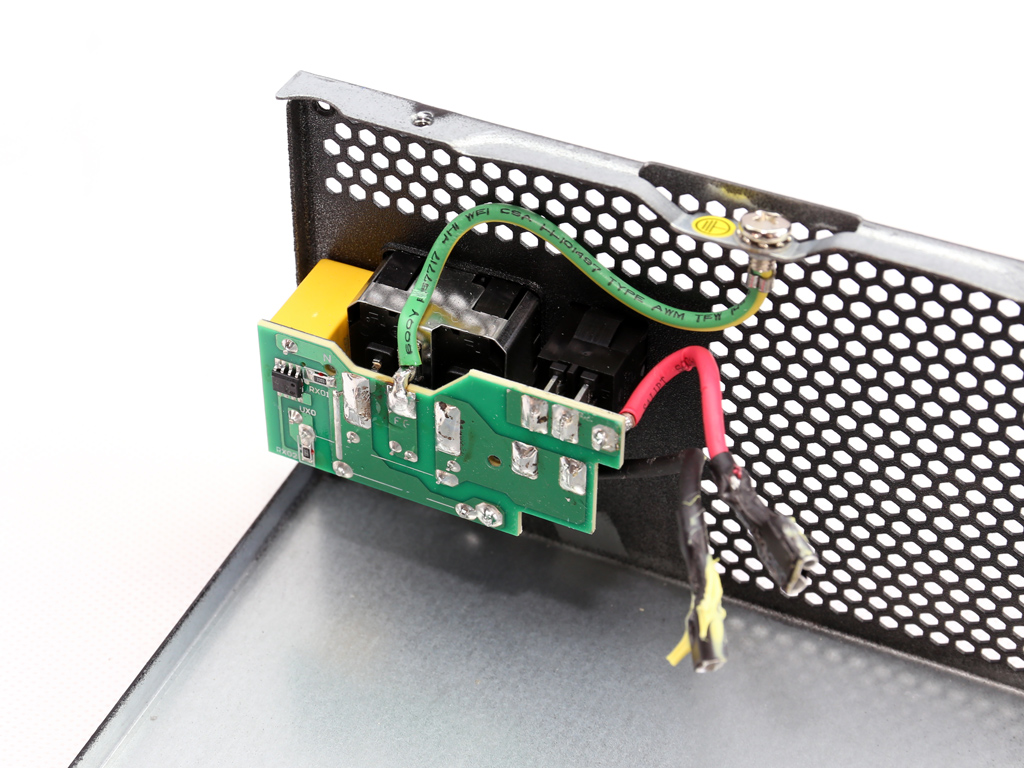



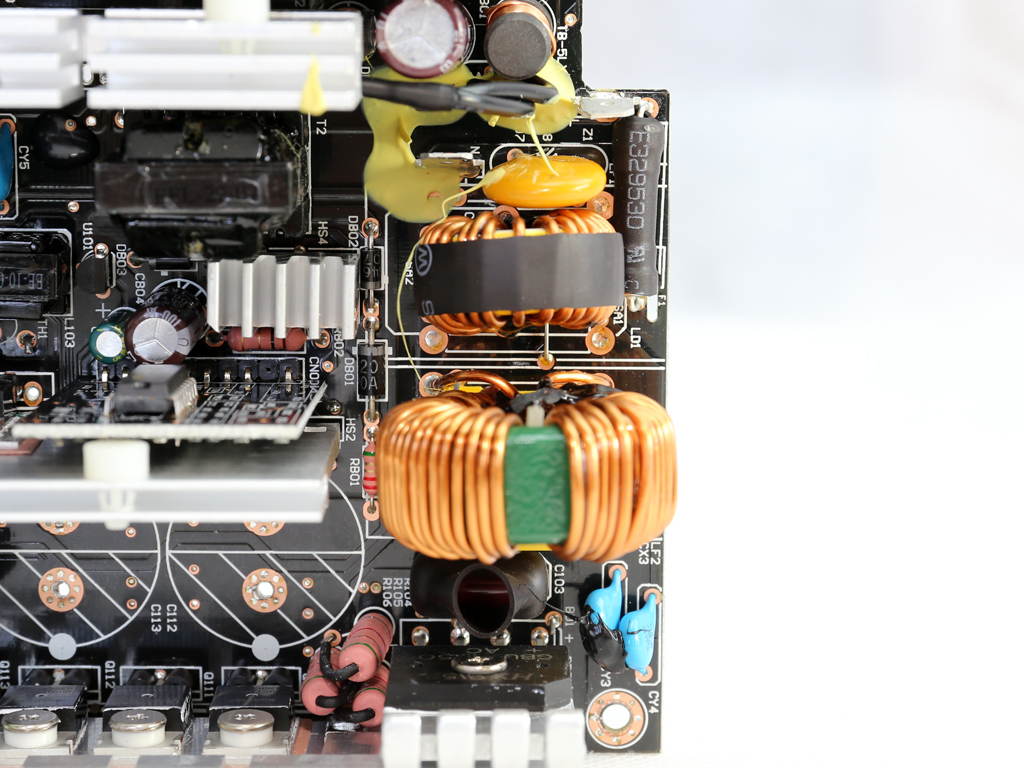
As usual, the first part of the transient filtering stage starts in the AC receptacle and includes one X and two Y caps. This part of the EMI filter also includes a CM02X, which blocks current through an X cap's discharge (bleeding) resistor once AC is connected. The same filter continues on the main PCB with the same number of X and Y caps, and two CM chokes, along with an MOV (Metal Oxide Varistor). The PFC input X cap is covered by heat-shrink tubing; its main purpose is to filter high-frequency ripple from the bridge rectifiers.


The pair of bridge rectifiers (2x GBU1506) handles up to 30A. Besides the primary heat sink, an additional (much smaller) one is used to cool the bridge rectifiers down.



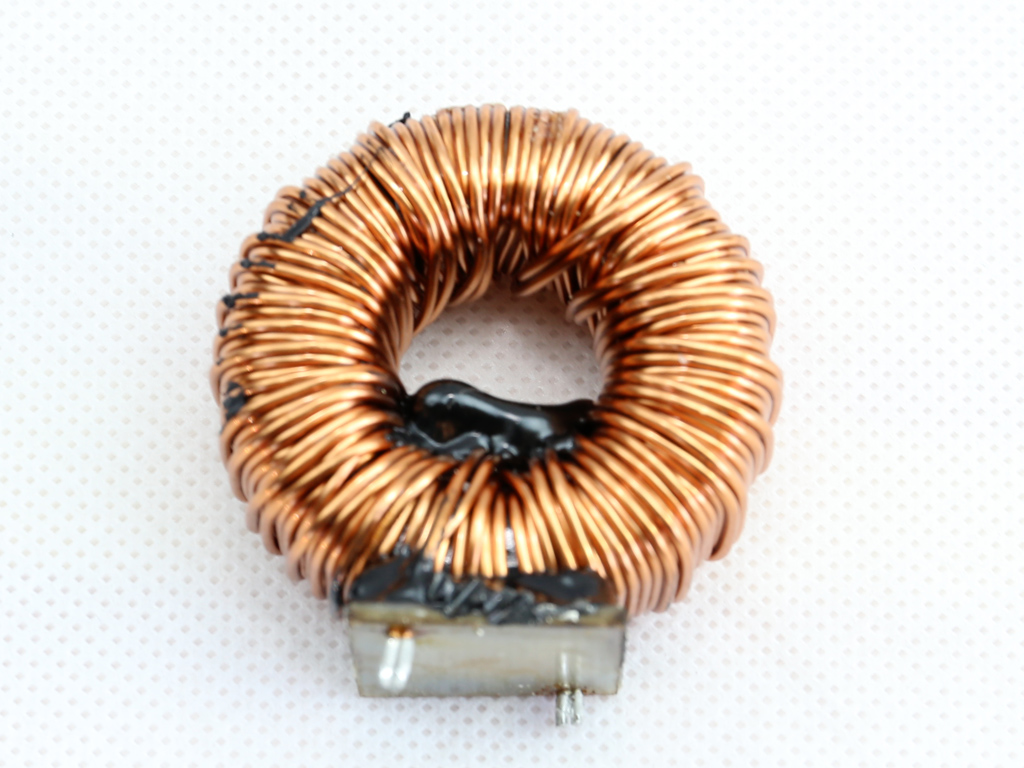

Four MagnaChip MDP13N50 FETs are installed in the APFC converter, along with two NXP BYC10-600 boost diodes. The increased number of components in this converter means that each of them deals with less current, so energy losses are lessened. To be frank, we didn't expect to find such a design choice in an affordable Bronze-rated unit. The pair of bulk caps is provided by Chemi-Con (400V, 2000h @ 105°C, KMR), and although 940uF of combined capacity looks ample for a 850W PSU, non-optimal tuning causes the power-good hold-up time to drop below 16ms. Fortunately, the hold-up time exceeds 17ms and the power-good signal is accurate.
Get Tom's Hardware's best news and in-depth reviews, straight to your inbox.
The combo PFC-PWM controller is Champion's legendary CM6800TX IC, which was particularly popular a few years ago. Nowadays we rarely see it since more PSUs offer Gold or higher efficiency certifications.
There is an NTC thermistor installed close to the bulk caps for protecting against large inrush currents. We took some IR shots of it and discovered that, while the PSU was on with its fan removed, the thermistor's operating temperatures climbed pretty high. This means its resistance is very low, so it won't waste significant amounts of energy. However, in the case of a hot-restart with the PSU's bulk caps drained, inrush current will go sky-high.


The primary switching FETs are two MagnaChip MDP18N50s installed in a double-forward topology, most likely.


On the secondary side, a passive design is used instead of a synchronous one with six On Semiconductor MBR30L60CT SBRs used for regulating the +12V rail.




A couple of DC-DC converters generate the minor rails. In total, six UBIQ QM3006D FETs are used along with two Anpec APW7073 PWM controllers.




Most filtering caps on the secondary side come from Teapo, a Taiwanese manufacturer with decent-quality products. The 850 BQ's caps belong to the SC series though, which isn't the best in Teapo's arsenal. Besides the Teapo caps, we also found several CapXon polymer caps.


The 5VSB rail uses an MBR10U60CT SBR. The standby PWM controller is covered by a small heat sink that we didn't want to remove.

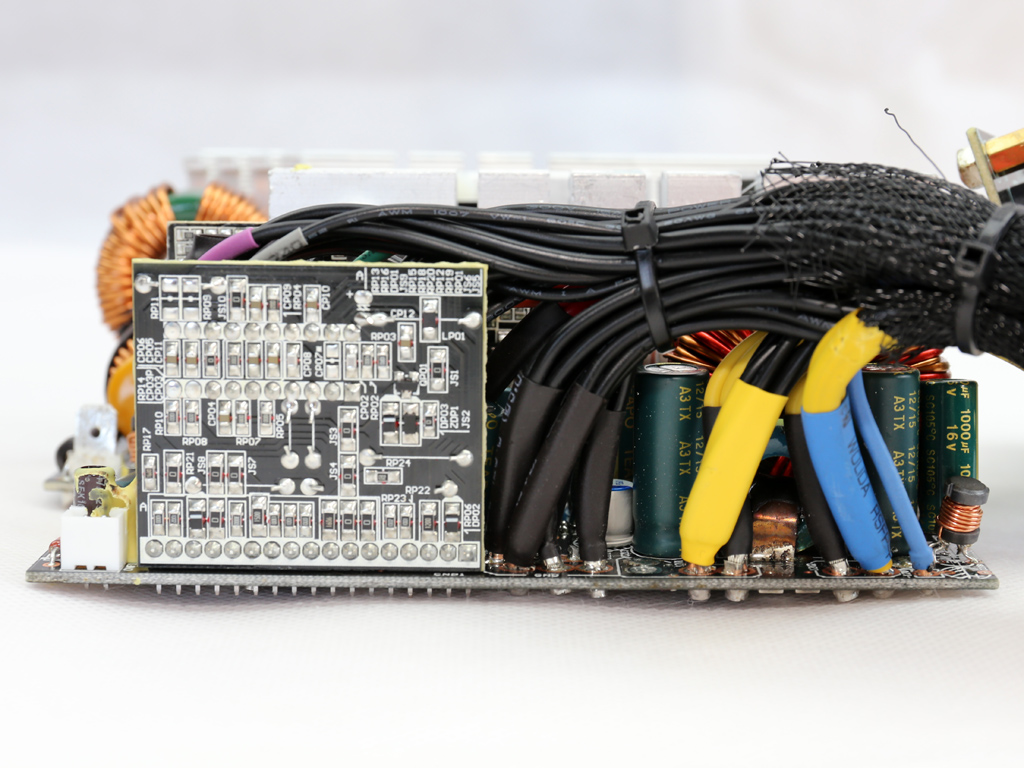

The supervisor IC is a Weltrend WT7527, which supports all protection features except OTP. The WT7527 also supports OCP for up to two +12V rails, even though EVGA's 850 BQ uses a single +12V rail.

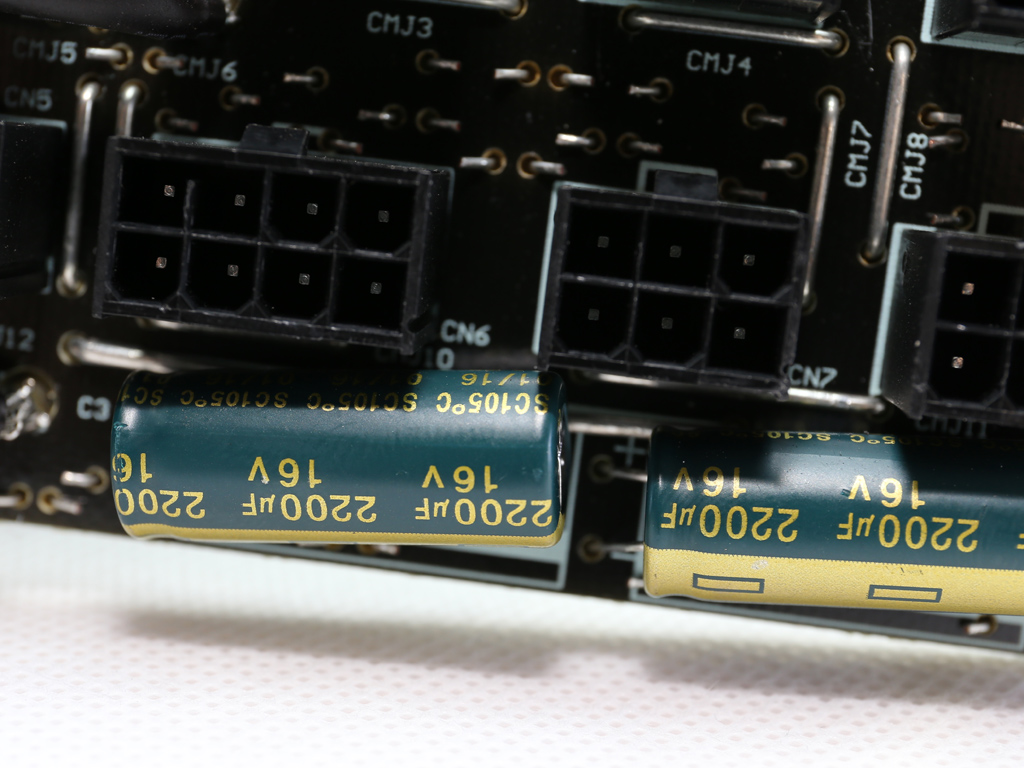



Three Teapo caps are installed on the front side of the modular board for ripple filtering. Around back, the soldering quality is satisfactory.










The soldering quality looks quite good, although we did spot some longer-than-usual component leads.


The cooling fan is sourced by Globe Fan and its model number is RL4Z T1352512HH. This fan has a 140mm diameter and uses a Teflon-coated bearing that promises a longer lifetime compared to sleeve bearing solutions. EVGA claims that this type of bearing offers low noise output and should last longer than 80,000 hours at 40°C ambient. Moreover, since it doesn't use oil, it isn't prone to leakage. It is more suitable for horizontal installation, too. The major downside of this fan is that its control circuit isn't optimally tuned, so even at its lowest speed you'll still hear noise. Although the fan's start-up voltage is around 2.5V, the minimum voltage used by the control circuit is 5.6V, which adds up to 1120 RPM and 38.8 dB(A) of noise.
Current page: A Look Inside And Component Analysis
Prev Page Packaging, Contents, Exterior, And Cabling Next Page Load Regulation, Hold-Up Time, And Inrush Current
Aris Mpitziopoulos is a contributing editor at Tom's Hardware, covering PSUs.
-
Metteec Also, for $20 more, you can pick up an equivalent gold rated PSU or maybe even a platinum one on sale and after rebates. It is the halcyon days for competition in quality PSUs.Reply -
_TheD0ct0r_ Reply19020704 said:Thanks for the review. Looks like I will be avoiding this one.
Why is that?
-
Metteec @_THEDICTOR_, for $85, there are so many other better options. EVGA could have been more competitive model if they made quieter version. Instead, you get a PSU with fixed cables, low efficiency, high power variances, and noise like a mini-vacuum. While the higher quality capacitors and warranty are nice, the lack of utility does not make this a good value. 3-years ago, this would have been a great PSU, but times have changed. It is a great day to buy a PSU, just not this one.Reply -
MasterMace appears to be another terrible unit. I'll have to read back and see if it's an Andyson or a HECReply -
Nuckles_56 I would have thought that EVGA could have pushed HEC a bit harder and got a much better unit out of them than thisReply -
lunyone I would personally like to see more 450-550w PSU reviews, not the cherry picked and delivered 750w+ ones that seem to make the rounds. It is just that most people are only going to need 450-550w PSU's for their 1 dGPU based systems.Reply -
Aris_Mp This is not a cherry-picked sample. It comes directly from a store shelf and not from EVGA.Reply
As for more 450-550W PSU reviews, I am currently working on a 500W unit (which however isn't affordable).

